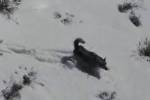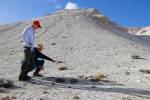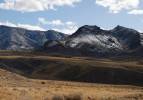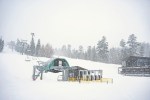5,200 acres protected for endangered Mount Charleston blue butterfly
Federal regulators have designated more than 5,200 acres high in the Spring Mountains as critical habitat for the endangered Mount Charleston blue butterfly, including one of the easiest places to see the incredibly rare insect: on the slopes at the Las Vegas Ski & Snowboard Resort.
The owners of the popular winter sports area at the top of Lee Canyon hoped to be excluded from the critical habitat area, but only a portion of the resort — mostly around its buildings and ski lifts — ended up being removed from the final plan unveiled Monday by the U.S. Fish & Wildlife Service.
During a public meeting last year, Jim Seely, marketing director for the ski area 50 miles northwest of the Strip, said being designated as critical habitat could derail plans to add new ski runs and summer attractions.
The ski resort has submitted a 12-year plan to the U.S. Forest Service that would double the size of the operation and add six ski lifts and more snow-making equipment. The resort, which operates on public land under a long-term Forest Service lease, also wants to increase traffic during the summer with a downhill mountain biking park on trails it hopes to finish by 2016.
Mike Senn, field supervisor for the Fish & Wildlife Service in Southern Nevada, said much of that can still be done with the proper planning and consultation. If done right, clearing forest for more ski runs could actually benefit the butterfly by producing more habitat as it has elsewhere in the ski area.
“They may not be able to do everything they want on every inch, but there’s plenty of room for expansion,” Senn said.
The Fish & Wildlife Service announced Monday it would set aside 5,241 acres for the butterfly no bigger than a quarter instead of the 5,561 acres proposed last year. Excluded along with a portion of the ski resort were several day-use areas and campgrounds with a high concentration of infrastructure, heavy recreational or management activity and little functional habitat.
The decision, which takes effect on July 30, is detailed in a Federal Register notice set for publication Tuesday.
The designation requires the Forest Service to consult with the Fish & Wildlife Service to ensure any management activity in those areas does not harm the butterfly or the host and nectar plants on which it depends.
The butterfly’s decline in recent years is blamed in part on a Forest Service fuel-reduction project that saw small trees and brush cut down, chipped and spread on the ground, effectively burying the Mount Charleston blue’s host plants and larvae.
The critical habitat is in three separate blocks at the top of Kyle and Lee canyons and along the road connecting the two, state Route 158, near Fletcher Peak. The largest of the three areas takes in a stretch of state Route 156 leading to the ski area and into Lee Canyon above it.
Roughly 99 percent of the habitat is federal land, and most of it is already protected as wilderness. The 1 percent that isn’t includes a few residences and some Clark County land, but Fish & Wildlife Service officials have said no new restrictions would be placed on private property.
The Mount Charleston blue is a distinctive subspecies of the wider-ranging Shasta blue butterfly, but it takes an expert eye to distinguish it from other varieties of small, meadow-loving butterflies. The males are iridescent blue and gray, the females a dull brown.
The exact population is unknown, but there could be fewer than 100 left in existence. The butterfly was listed as an endangered species in 2013.
Conservationists hailed Monday’s habitat designation.
“The Mount Charleston blue is one of the most endangered butterflies in the world, so it’s wonderful news that this beautiful little guy finally has protected critical habitat under the Endangered Species Act,” said Tierra Curry, a senior scientist for the Tucson, Ariz.-based environmental group Center for Biological Diversity. “We can’t save this unique Las Vegas butterfly without protecting the places it lives in the Spring Mountains, and designating critical habitat is a great way to do that.”
Contact Henry Brean at hbrean@reviewjournal.com or 702-383-0350. Find him on Twitter: @RefriedBrean
RELATED
‘Critical habitat’ for Mount Charleston blue butterfly covers 5,500 acres
Mount Charleston blue butterfly declared endangered species
Wildfire could harm species found only on Mount Charleston
Federal wildlife agency recommends protecting Mount Charleston blue, five other butterflies




























